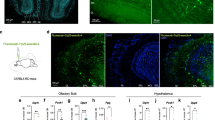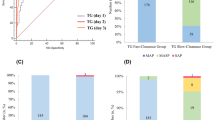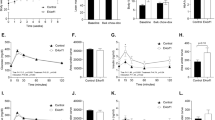Abstract
Aim:
TGR5 agonists stimulate intestinal glucagon-like peptide-1 (GLP-1) release, but systemic exposure causes unwanted side effects, such as gallbladder filling. In the present study, linagliptin, a DPP-4 inhibitor with a large molecular weight and polarity, and MN6, a previously described TGR5 agonist, were linked to produce OL3, a novel low-absorbed TGR5 agonist with reduced side-effects and dual function in lowering blood glucose by activation of TGR5 and inhibition of DPP-4.
Methods:
TGR5 activation was assayed in HEK293 cells stably expressing human or mouse TGR5 and a CRE-driven luciferase gene. DPP-4 inhibition was assessed based on the rate of hydrolysis of a surrogate substrate. GLP-1 secretion was measured in human enteroendocrine NCI-H716 cells. OL3 permeability was tested in Caco-2 cells. Acute glucose-lowering effects of OL3 were evaluated in ICR and diabetic ob/ob mice.
Results:
OL3 activated human and mouse TGR5 with an EC50 of 86.24 and 17.36 nmol/L, respectively, and stimulated GLP-1 secretion in human enteroendocrine NCI-H716 cells (3–30 μmol/L). OL3 inhibited human and mouse DPP-4 with IC50 values of 18.44 and 69.98 μmol/L, respectively. Low permeability of OL3 was observed in Caco-2 cells. In ICR mice treated orally with OL3 (150 mg/kg), the serum OL3 concentration was 101.10 ng/mL at 1 h, and decreased to 13.38 ng/mL at 5.5 h post dose, confirming the low absorption of OL3 in vivo. In ICR mice and ob/ob mice, oral administration of OL3 significantly lowered the blood glucose levels, which was a synergic effect of activating TGR5 that stimulated GLP-1 secretion in the intestine and inhibiting DPP-4 that cleaved GLP-1 in the plasma. In ICR mice, oral administration of OL3 did not cause gallbladder filling.
Conclusion:
OL3 is a low-absorbed TGR5 agonist that lowers blood glucose without inducing gallbladder filling. This study presents a new strategy in the development of potent TGR5 agonists in treating type 2 diabetes, which target to the intestine to avoid systemic side effects.
Similar content being viewed by others
Log in or create a free account to read this content
Gain free access to this article, as well as selected content from this journal and more on nature.com
or
References
Maruyama T, Miyamoto Y, Nakamura T, Tamai Y, Okada H, Sugiyama E, et al. Identification of membrane-type receptor for bile acids (M-BAR). Biochem Biophys Res Commun 2002; 298: 714–9.
Pols TW, Noriega LG, Nomura M, Auwerx J, Schoonjans K . The bile acid membrane receptor TGR5 as an emerging target in metabolism and inflammation. J Hepatol 2011; 54: 1263–72.
Kawamata Y, Fujii R, Hosoya M, Harada M, Yoshida H, Miwa M, et al. A G protein-coupled receptor responsive to bile acids. J Biol Chem 2003; 278: 9435–40.
Lieu T, Jayaweera G, Bunnett NW . GPBA: a GPCR for bile acids and an emerging therapeutic target for disorders of digestion and sensation. Br J Pharmacol 2014; 171: 1156–66.
Potthoff MJ, Potts A, He T, Duarte JA, Taussig R, Mangelsdorf DJ, et al. Colesevelam suppresses hepatic glycogenolysis by TGR5-mediated induction of GLP-1 action in DIO mice. Am J Physiol Gastrointest Liver Physiol 2013; 304: G371–80.
Katsuma S, Hirasawa A, Tsujimoto G . Bile acids promote glucagon-like peptide-1 secretion through TGR5 in a murine enteroendocrine cell line STC-1. Biochem Biophys Res Commun 2005; 329: 386–90.
Thomas C, Gioiello A, Noriega L, Strehle A, Oury J, Rizzo G, et al. TGR5-mediated bile acid sensing controls glucose homeostasis. Cell Metab 2009; 10: 167–77.
Parker HE, Wallis K, le Roux CW, Wong KY, Reimann F, Gribble FM . Molecular mechanisms underlying bile acid-stimulated glucagon-like peptide-1 secretion. Br J Pharmacol 2012; 165: 414–23.
Stoffers DA, Kieffer TJ, Hussain MA, Drucker DJ, Bonner-Weir S, Habener JF, et al. Insulinotropic glucagon-like peptide 1 agonists stimulate expression of homeodomain protein IDX-1 and increase islet size in mouse pancreas. Diabetes 2000; 49: 741–8.
Watanabe M, Houten SM, Mataki C, Christoffolete MA, Kim BW, Sato H, et al. Bile acids induce energy expenditure by promoting intracellular thyroid hormone activation. Nature 2006; 439: 484–9.
Watanabe M, Morimoto K, Houten SM, Kaneko-Iwasaki N, Sugizaki T, Horai Y, et al. Bile acid binding resin improves metabolic control through the induction of energy expenditure. PloS One 2012; 7: e38286.
Li T, Holmstrom SR, Kir S, Umetani M, Schmidt DR, Kliewer SA, et al. The G protein-coupled bile acid receptor, TGR5, stimulates gallbladder filling. Mol Endocrinol 2011; 25: 1066–71.
Lavoie B, Balemba OB, Godfrey C, Watson CA, Vassileva G, Corvera CU, et al. Hydrophobic bile salts inhibit gallbladder smooth muscle function via stimulation of GPBAR1 receptors and activation of KATP channels. J Physiol 2010; 588: 3295–305.
Stepanov V, Stankov K, Mikov M . The bile acid membrane receptor TGR5: a novel pharmacological target in metabolic, inflammatory and neoplastic disorders. J Receptor Signal Transduction Res 2013; 33: 213–23.
Fryer RM, Ng KJ, Nodop Mazurek SG, Patnaude L, Skow DJ, Muthukumarana A, et al. G protein-coupled bile acid receptor 1 stimulation mediates arterial vasodilation through a K(Ca)1.1 (BK(Ca))-dependent mechanism. J Pharmacol Exp Ther 2014; 348: 421–31.
Piotrowski DW, Futatsugi K, Warmus JS, Orr ST, Freeman-Cook KD, Londregan AT, et al. Identification of tetrahydropyrido[4,3-d]pyrimidine amides as a new class of orally bioavailable TGR5 agonists. ACS Med Chem Lett 2013; 4: 63–8.
Evans KA, Budzik BW, Ross SA, Wisnoski DD, Jin J, Rivero RA, et al. Discovery of 3-aryl-4-isoxazolecarboxamides as TGR5 receptor agonists. J Med Chem 2009; 52: 7962–5.
Harach T, Pols TW, Nomura M, Maida A, Watanabe M, Auwerx J, et al. TGR5 potentiates GLP-1 secretion in response to anionic exchange resins. Sci Rep 2012; 2: 430.
Duan H, Ning M, Chen X, Zou Q, Zhang L, Feng Y, et al. Design, synthesis, and antidiabetic activity of 4-phenoxynicotinamide and 4-phenoxypyrimidine-5-carboxamide derivatives as potent and orally efficacious TGR5 agonists. J Med Chem 2012; 55: 10475–89.
Duan H, Ning M, Zou Q, Ye Y, Feng Y, Zhang L, et al. Discovery of intestinal targeted TGR5 agonists for the treatment of type 2 diabetes. J Med Chem 2015; 58: 3315–28.
Lipinski CA, Lombardo F, Dominy BW, Feeney PJ . Experimental and computational approaches to estimate solubility and permeability in drug discovery and development settings. Adv Drug Delivery Rev 2001; 46: 3–26.
Pang Z, Nakagami H, Osako MK, Koriyama H, Nakagami F, Tomioka H, et al. Therapeutic vaccine against DPP4 improves glucose metabolism in mice. Proc Natl Acad Sci U S A 2014; 111: E1256–63.
Tella SH, Rendell MS . DPP–4 inhibitors: focus on safety. Expert Opin Drug Safety 2015; 14: 127–40.
Janardhan S, Sastry GN . Dipeptidyl peptidase IV inhibitors: a new paradigm in type 2 diabetes treatment. Curr Drug Targets 2014; 15: 600–21.
Brunton S . GLP-1 receptor agonists vs DPP-4 inhibitors for type 2 diabetes: is one approach more successful or preferable than the other? Int J Clin Practice 2014; 68: 557–67.
Thomas L, Eckhardt M, Langkopf E, Tadayyon M, Himmelsbach F, Mark M . (R)-8-(3-amino-piperidin-1-yl)-7-but-2-ynyl-3-methyl-1-(4-methyl-quinazolin-2-ylmethyl)-3,7-dihydro-purine-2,6-dione (BI 1356), a novel xanthine-based dipeptidyl peptidase 4 inhibitor, has a superior potency and longer duration of action compared with other dipeptidyl peptidase-4 inhibitors. J Pharmacol Exp Ther 2008; 325: 175–82.
Zou Q, Duan H, Ning M, Liu J, Feng Y, Zhang L, et al. 4-Benzofuranyloxynicotinamide derivatives are novel potent and orally available TGR5 agonists. Eur J Med Chem 2014; 82: 1–15.
Furuta Y, Horiguchi M, Sugaru E, Ono-Kishino M, Otani M, Sakai M, et al. Chronic administration of DSP-7238, a novel, potent, specific and substrate-selective DPP IV inhibitor, improves glycaemic control and beta-cell damage in diabetic mice. Diabetes Obesity Metab 2010; 12: 421–30.
Pellicciari R, Gioiello A, Macchiarulo A, Thomas C, Rosatelli E, Natalini B, et al. Discovery of 6alpha-ethyl-23(S)-methylcholic acid (S-EMCA, INT-777) as a potent and selective agonist for the TGR5 receptor, a novel target for diabesity. J Med Chem 2009; 52: 7958–61.
Deacon CF, Holst JJ . Linagliptin, a xanthine-based dipeptidyl peptidase-4 inhibitor with an unusual profile for the treatment of type 2 diabetes. Expert Opin Invest Drugs 2010; 19: 133–40.
Kim K, Park M, Lee YM, Rhyu MR, Kim HY . Ginsenoside metabolite compound K stimulates glucagon-like peptide-1 secretion in NCI-H716 cells via bile acid receptor activation. Arch Pharmacal Res 2014; 37: 1193–200.
Le Neve B, Daniel H . Selected tetrapeptides lead to a GLP-1 release from the human enteroendocrine cell line NCI-H716. Regul Peptides 2011; 167: 14–20.
Li YH, Bi HC, Huang L, Jin J, Zhong GP, Zhou XN, et al. Phorbol 12-myristate 13-acetate inhibits P-glycoprotein-mediated efflux of digoxin in MDCKII-MDR1 and Caco-2 cell monolayer models. Acta Pharmacol Sin 2014; 35: 283–91.
Duboc H, Tache Y, Hofmann AF . The bile acid TGR5 membrane receptor: from basic research to clinical application. Dig Liver Dis 2014; 46: 302–12.
Tiwari A, Maiti P . TGR5: an emerging bile acid G-protein-coupled receptor target for the potential treatment of metabolic disorders. Drug Discov Today 2009; 14: 523–30.
Barnett AH . Linagliptin for the treatment of type 2 diabetes mellitus: a drug safety evaluation. Expert Opin Drug Safety 2015; 14: 149–59.
Artursson P, Palm K, Luthman K . Caco-2 monolayers in experimental and theoretical predictions of drug transport. Adv Drug Delivery Rev 2001; 46: 27–43.
Haluzik M, Colombo C, Gavrilova O, Chua S, Wolf N, Chen M, et al. Genetic background (C57BL/6J versus FVB/N) strongly influences the severity of diabetes and insulin resistance in ob/ob mice. Endocrinology 2004; 145: 3258–64.
Liu X, Zhang LN, Feng Y, Zhang L, Qu H, Cao GQ, et al. Acute and chronic administration of SHR117887, a novel and specific dipeptidyl peptidase-4 inhibitor, improves metabolic control in diabetic rodent models. Acta Pharmacol Sin 2012; 33: 1013–2.
Acknowledgements
This work was financially supported by a grant from the National Natural Science Foundation of China (No 81473093), a grant from the State Key Laboratory of Drug Research (No SIMM1403ZZ-03) and a grant from the Shanghai Institute of Materia Medica (No CASIMM0120152030).
Author information
Authors and Affiliations
Corresponding authors
Rights and permissions
About this article
Cite this article
Ma, Sy., Ning, Mm., Zou, Qa. et al. OL3, a novel low-absorbed TGR5 agonist with reduced side effects, lowered blood glucose via dual actions on TGR5 activation and DPP-4 inhibition. Acta Pharmacol Sin 37, 1359–1369 (2016). https://doi.org/10.1038/aps.2016.27
Received:
Accepted:
Published:
Issue date:
DOI: https://doi.org/10.1038/aps.2016.27



